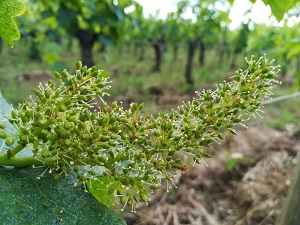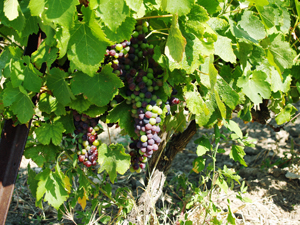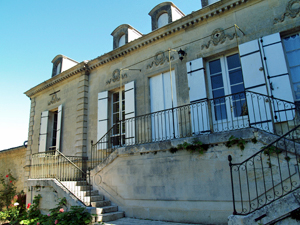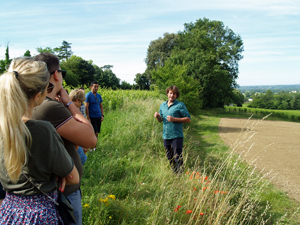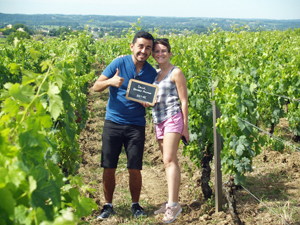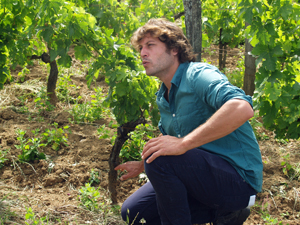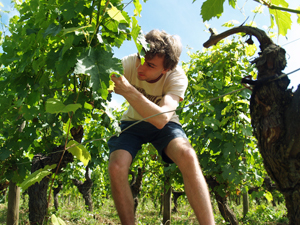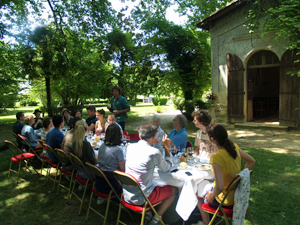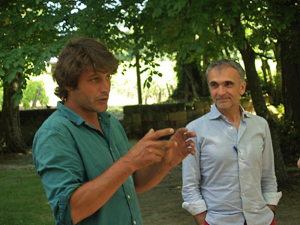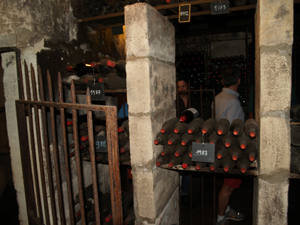We spent another great Gourmet Odyssey Wine Experience weekend in Saint-Emilion at Château Coutet with the David Beaulieu family. They have been making wine here for over 400 years and have a unique story to tell, not just from the 14 generations of wine-makers, but also because they have always been organic and have never used any chemical products on their vines. We were to hear more about what makes Château Coutet unique throughout the day, but the main focus was on learning about all of the work in the vineyard needed to nurture the vines and produce the best possible grapes at harvest time.
After the introductions, we made our way through the vineyards and up the hill. On the way, we learnt about the different grape varietals of Merlot, Cabernet Franc, Cabernet Sauvignon, and Malbec that are grown on the estate, and we marvelled at the trees and hedgerows that help to make up the special ecosystem of the winery. Around 20% of the winery’s surface area is voluntarily set aside from growing vines to preserve and encourage the biodiversity, which in turn helps maintain a natural equilibrium.
From the top of the hill, we had a good vantage point over the plain below, stretching past Libourne to Fronsac, and across the Dordogne River into the Entre Deux Mers wine-growing region. Here we learnt the role that the landscape plays in influencing the weather in Saint-Emilion, and could see how the soil changes from the sandy loam flood plain, to the clay limestone on the side of the hill, to the limestone plateau at the top. The vines at Château Coutet grow on these three distinct terroir.
Up on the plateau, we made our way to the Peycocut vineyard, one of the 12 reference vineyards in Saint-Emilion, traditionally used by the Jura to determine the date for the harvest. This is where the Gourmet Odyssey adopted vines are located, and we took a few minutes to visit our vines, admire the views of the rolling vineyards, and take a few pictures.
The work in the vineyard began during the cold winter months with pruning. We learnt how this is done, and were brought up to speed on the other work accomplished so far this year to de-bud the vines, raise the training wires, and work the soil.
The past few months have been warm and wet. This has meant that the vines have grown rampantly, but it is also been the ideal conditions for mildew to flourish. Whilst walking in the vineyards we could see some of the tell-tale yellow spots on the vine leaves. With the heavy downpours of rain, it hasn’t always been possible to get the tractor into the vineyard to treat the vines when needed. As the vineyard is organic and the bouillie bordelaise used to protect the vines from mildew is a contact product, it gets washed away and needs to be reapplied after each 20mm of rain.
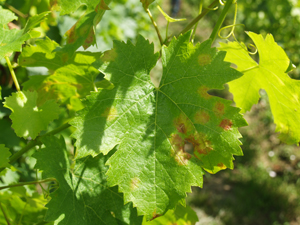
Another way to help reduce the spread and impact of mildew is to remove some of the leaves around the grapes, which improves the air flow and speeds up the drying time after any rain. This was the job that had been set aside for us, and we were shown how to do so. The first factor to take into consideration is the alignment of the vines. In the Bordeaux region the summer months can get very hot with strong sunshine. The leaves are therefore only removed on the east facing side which receives the gentler morning sun. The leaves are kept on the other side to protect the grapes from the more powerful afternoon sun. The leaves to be removed are those directly in front of the grapes and any which touch the grapes and could transport moisture to the grapes from the rest of the plant.
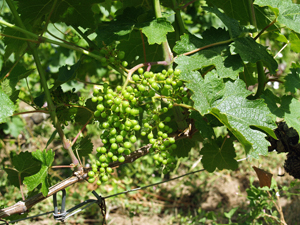
After watching the winemakers do this expertly, we spread out in pairs to have a go ourselves. It’s not the most intellectually demanding task, but we soon learnt that it’s more physically demanding that you might think, and that there is a real technique needed to go fast.
We then headed back to the winery, and enjoyed a well earned glass of chilled Clairet rosé wine in the shade of the magnificent trees in the chateau’s garden.
Lunch was delicious as usual, prepared on site by the excellent caterers. We had foie-gras with fig chutney and savoury breads for starter, followed by magret de canard with a 4 spice sauce, mashed potato with truffle oil, and garden vegetables. To accompany these dishes, we tasted the Château’s second wine, Belles-Cîmes 2015, and compared the 2014 and 2015 vintages of the Château Coutet. We then tasted the Cuvée Demoiselle 2014 with the cheese and dessert.
After lunch, we talked some more about how the winery is managed organically, and has always been so since time began. We also learnt about the work left to do in the vineyard before the harvest, and how the winemakers will tell when the grapes are ripe enough to be picked.
The day ended with a quick visit of the chai, family cellar, and barrel room. The family cellar is full of old vintage wines going back over the past 50 years or so, and everyone tried to find the bottles from their birth years.
We’ll be spending more time in the chai during the Vinification Experience Day next year. For now we have to wait patiently as the grapes ripen before returning in September to help pick the grapes during the Harvest Experience Day.



